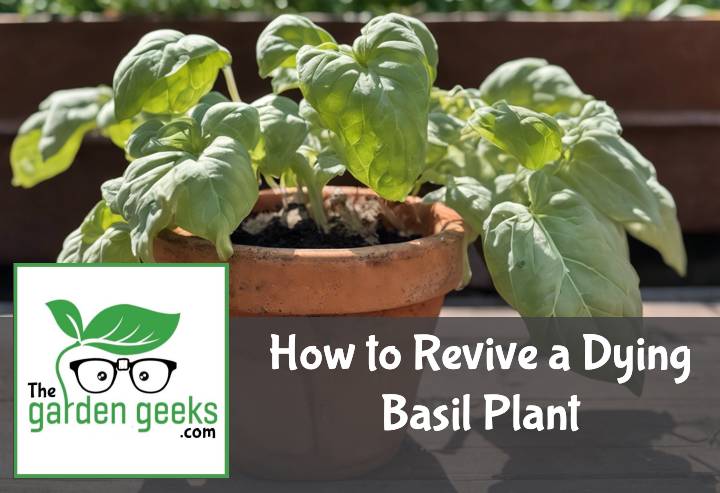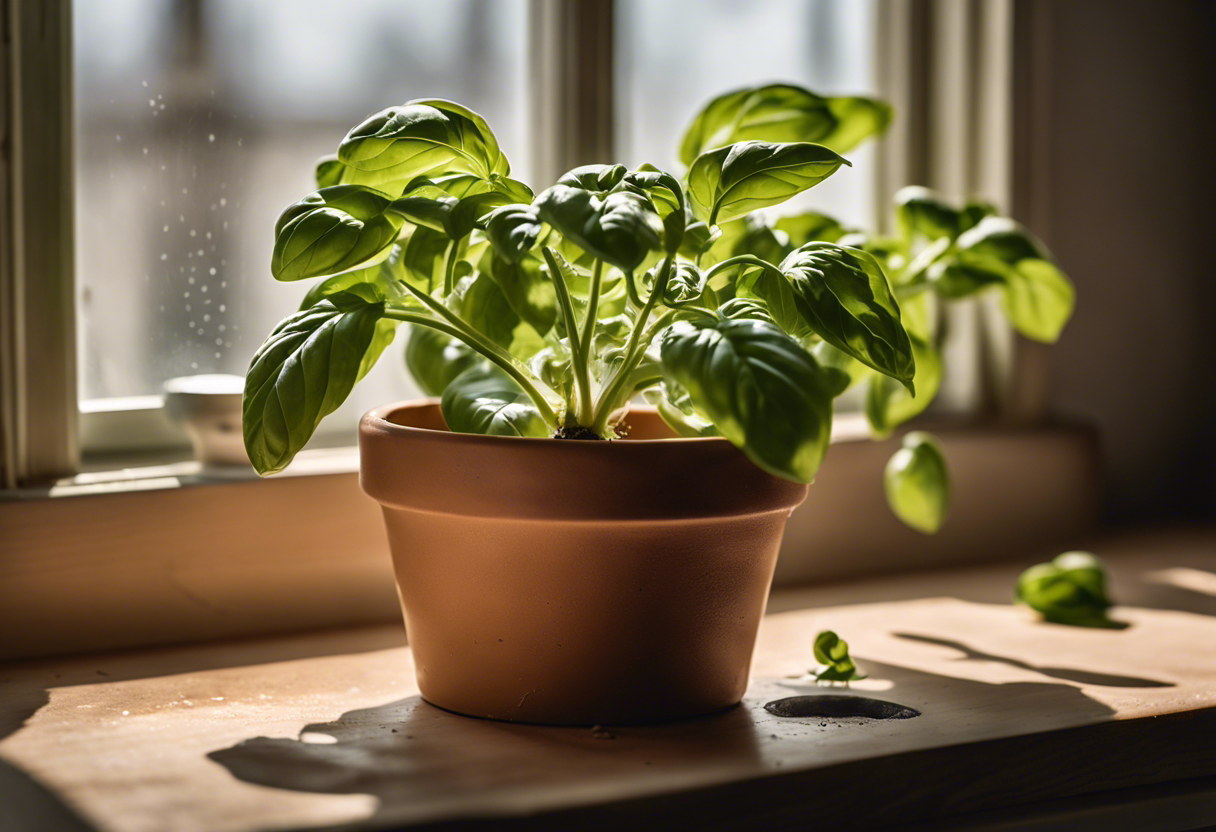Ever found yourself in a pickle, staring at your wilted, dying basil plant and wondering how to bring it back to life? Well, you’re not alone. I remember the first time my beloved basil drooped its leaves, looking as if it had given up on life. That’s when I decided to learn How to Revive a Dying Basil Plant.
In this post, we’ll dive into the nitty-gritty of resurrecting your green friend from the brink of extinction. So buckle up! It’s going to be a wild ride filled with soil amendments, light adjustments, and perhaps a prayer or two. Keep reading about How to Revive a Dying Basil Plant!
Key Takeaways
- Identify the problem: Overwatering, underwatering, lack of sunlight or pest infestation can cause a basil plant to wilt.
- Correct watering: Basil plants need well-drained soil and should not be watered until the top inch of soil is dry.
- Provide adequate sunlight: Basil needs 6-8 hours of direct sunlight daily.
- Pest control: Use organic pesticides or introduce beneficial insects to combat pests.
- Prune regularly: Remove dead leaves and flowers to promote growth. If all else fails, propagate new plants from healthy cuttings.
Understanding the Problem
Before you can figure out how to revive a dying basil plant, it’s crucial to understand what’s going wrong. Recognizing basil plant problems and identifying signs of decline are key steps in this process.
Identifying Signs of a Dying Basil Plant
So, how do you spot a sickly basil? Well, your plant might be screaming “Help me!” if you notice yellowing basil leaves or a generally wilting basil plant. These are some of the most common dying basil symptoms.
But wait, there’s more! If your once lush green beauty now sports brown spots on leaves, that’s another red flag. And don’t forget about growth – or lack thereof. A sudden case of stunted growth in basil could mean trouble in paradise.
Finally, keep an eye out for those droopy fellows. Yes, I’m talking about drooping basil leaves. They’re not just tired; they’re a sign that your plant is crying out for help!
Common Reasons for Basil Plant Decline
Now that we’ve covered the signs, let’s dive into why your basil might be on the decline. One common culprit is water – too much or too little can lead to big problems like overwatering basil plants or under watering issues.
Next up: pests. Those tiny critters love munching on your precious greens, causing significant pest damage on basil.
And don’t forget about sunlight and soil! Lack of sunlight can leave your basils feeling blue, while poor soil conditions can stunt their growth and overall health. So remember folks, when it comes to basil plant care, it’s all about balance!
Assessing Your Basil Plant’s Environment
In the journey of how to revive a dying basil plant, the first pit stop is assessing your basil’s environment. It’s like being a plant detective, looking for clues in light conditions, soil quality and drainage, and temperature and humidity factors. This is the crux of basil plant care.
Evaluating Light Conditions
Now let’s talk about sunlight. Basil plants are sun worshippers! They need at least 6 hours of direct sunlight each day. If you notice your basil turning yellow or wilting, it might be crying out for more light.
On the flip side, too much of a good thing can also be harmful. If your basil leaves start to look scorched or dried out, they’re probably getting too much sun. Adjusting sunlight for basil plants is key in maintaining their health.
Checking Soil Quality and Drainage
Next up on our checklist is soil quality and drainage. Basil loves well-drained soil that’s rich in organic matter. If you’re growing your basil indoors or in pots, make sure there’s adequate drainage at the bottom.
If water pools on top after watering or if the pot feels heavy long after watering, you’ve got a drainage problem on your hands. Improving soil for basil can significantly help with reviving your dying plant.
Considering Temperature and Humidity Factors
Last but not least, we have temperature and humidity factors to consider. Basil thrives in warm temperatures between 50°F (10°C) to 86°F (30°C).
If your plant looks droopy despite proper watering, it could be feeling cold. On the other hand, if it starts showing signs of heat stress like wilting or browning edges despite ample water supply, it might be too hot.
Humidity plays its part too; basil prefers moderate humidity levels around 40-70%. If the air is too dry, your basil might start to wilt. So, keep a check on humidity levels for basil plants as well.
Reviving Techniques for a Dying Basil Plant
When it comes to how to revive a dying basil plant, there are several techniques you can try. These include adjusting watering practices, modifying light exposure, and improving soil conditions. Let’s dive into these methods!
Adjusting Watering Practices
First things first, let’s talk about basil watering needs. Like Goldilocks and her porridge, basil plants don’t like too much or too little water – they need it just right!
If your basil is looking a bit sad and wilted, it might be an overwatered basil plant or an underwatered basil plant. Signs of overwatering include yellow leaves and root rot while underwatering will make the plant look dry and shriveled.
Adjusting your watering schedule can help bring your basil back from the brink. Remember, it’s better to underwater than overwater as basil plants are quite drought-tolerant.
Modifying Light Exposure
Next up on our revival tour is light exposure. Basil plants love sunlight – in fact, they need at least 6 hours of direct sunlight each day. If your indoor basil isn’t getting enough natural light, you may need to supplement with artificial lighting.
Remember that basil light requirements aren’t just about quantity but also quality. Too much harsh afternoon sun can scorch the leaves while too little light can lead to weak and leggy growth.
So adjust accordingly based on where you live and the current season. Your basil will thank you for it!
Improving Soil Conditions
Last but not least, let’s talk dirt – literally! The soil in which your basil grows plays a big role in its health.
Basil prefers well-draining soil that’s rich in organic matter. If your current soil isn’t cutting it, consider adding some organic compost for basils to improve its quality.
Remember, different soil types for basil plants can affect how well your plant grows. So don’t be afraid to experiment until you find what works best for your green buddy.
In the end, reviving a dying basil plant is all about understanding its needs and making the necessary adjustments. With a bit of patience and care, you’ll have your basil back in tip-top shape in no time!
Preventive Measures to Keep Your Basil Healthy
When it comes to maintaining basil plant health, prevention is better than cure. It’s all about regular pruning, pest control, and proper fertilization. These preventive measures for plants are the key to healthy basil growth.
Regular Pruning and Harvesting
Pruning and harvesting aren’t just about reaping what you sow. They’re essential parts of basil plant maintenance. Regularly giving your basil a little trim can stimulate growth and prevent disease.
The right basil pruning techniques can make a world of difference. You want to cut just above where two large leaves meet, encouraging the plant to branch out. As for timing, early morning is best when the plant’s full of moisture.
And don’t forget about harvesting! The benefits of regular harvesting are twofold: you get fresh basil for your pasta, and your plant stays healthy. Just remember: always be gentle when plucking those leaves.
Pest Control Methods
Pests can be a real party pooper in your basil’s growth journey. But don’t worry, there are plenty of ways to keep them at bay!
You’ll want to opt for organic pest control for basil, which is both effective and eco-friendly. Neem oil or insecticidal soap sprays work wonders against aphids and whiteflies.
If you’re dealing with slugs or snails, try setting up beer traps around your plants (yes, they love beer as much as we do!). Remember that consistency is key when it comes to controlling pests in your beloved basil plants.
Fertilization Tips
Last but not least: fertilization! Feeding your basil the right nutrients can significantly boost its health and yield.
When choosing a fertilizer, go organic if possible. Compost or worm castings are great options that provide a slow release of nutrients. They’re like the gourmet meal of best fertilizer for basil plants.
As for frequency, less is more. Over-fertilizing can harm your plant more than help it. A good rule of thumb is to fertilize once every four to six weeks during the growing season.
And there you have it! With these preventive measures in place, you’ll be well on your way to mastering how to revive a dying basil plant.
To Wrap Up
In a nutshell, reviving a dying basil plant is like giving CPR to a goldfish – it’s tricky but totally possible! The key is spotting the signs early and acting fast. Just remember: water, light, and love (and maybe some fertilizer).
So don’t throw in the trowel just yet! For more detailed tips on How to Revive a Dying Basil Plant, check out our full guide. Your green thumb might surprise you yet!





